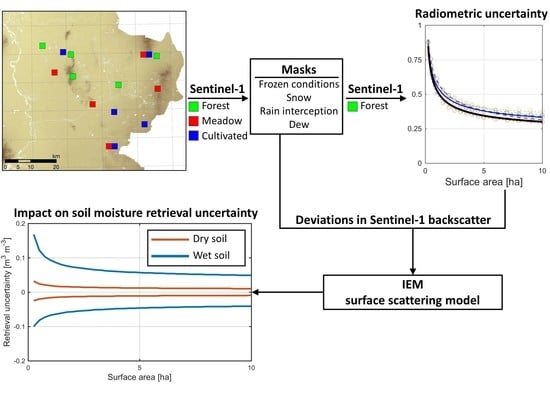Impacts of Radiometric Uncertainty and Weather-Related Surface Conditions on Soil Moisture Retrievals with Sentinel-1
Abstract
:1. Introduction
2. Study Area and Data
2.1. Twente Region and Meteorological Measurements
2.2. Sentinel-1 Imagery
3. Methods
3.1. Sentinel-1 Seasonal Anomalies
3.2. Sentinel-1 Masks for Weather-Related Surface Conditions
3.2.1. Frozen Conditions
3.2.2. Snow
3.2.3. Rain Interception
3.2.4. Dew
3.3. Sentinel-1 Radiometric Uncertainty
3.4. Impact on Soil Moisture Retrieval Accuracy
4. Results and Discussion
4.1. Sentinel-1 Timeseries and Seasonal Anomalies
4.2. Effects by Weather-Related Surface Conditions
4.2.1. Frozen Conditions
4.2.2. Snow
4.2.3. Rain Interception
4.2.4. Dew
4.2.5. Summary of the Masking Rules
4.3. Radiometric Uncertainty
4.4. Impact on Soil Moisture Retrievals
5. Conclusions
- Sentinel-1 observations of forests, meadows and cultivated fields are affected by frozen conditions below an air temperature of 1 , on average by retain-explicit-plus dB. Intercepted rain affects the after more than of rain in the 12 h preceding an observation, on average by retain-explicit-plus dB. Snow affects the observations of meadows and cultivated fields that were acquired in the Sentinel-1 morning overpasses on average by retain-explicit-plus dB. We could not find a systematic effect of dew on the Sentinel-1 observations, so no masking rule for dew was formulated.
- Frozen conditions, snow and intercepted rain have the largest effect on the Sentinel-1 observations of cultivated fields in comparison to forest and meadow observations.
- The effects of frozen conditions, snow and intercepted rain are larger on the Sentinel-1 observations in VH than in VV polarization.
- The Sentinel-1 radiometric uncertainty improves from dB () to dB (10 ) for the VV polarization and from dB () to dB (10 ) for the VH polarization.
- The radiometric uncertainty is approximately inversely proportional to the square root of the surface area over which the Sentinel-1 observations are averaged.
- If not masked, intercepted rain causes a significant overestimation of soil moisture ranging from retain-explicit-plus for dry soils (soil moisture equal to ) up to retain-explicit-plus for wet soils (soil moisture equal to ), averaged over the meadows and cultivated fields. Snow and frozen conditions lead to a significant decrease in soil moisture retrievals, from retain-explicit-plus and retain-explicit-plus for dry soils up to retain-explicit-plus and retain-explicit-plus for wet soils respectively.
- The soil moisture retrieval uncertainty as a result of radiometric uncertainty is minimum retain-explicit-plus to retain-explicit-plus for dry soils and large surface areas, and maximum retain-explicit-plus to retain-explicit-plus for wet soils and small surface areas.
- At the 1 spatial resolution that Paloscia et al. [61] proposed for an operational Sentinel-1 soil moisture product, radiometric uncertainty still leads to soil moisture retrieval uncertainty ranging from for dry soils to for wet soils. Especially in the wet soil moisture range the radiometric uncertainty consumes a significant portion of the accuracy requirement proposed for this soil moisture product [61].
- The impact on soil moisture retrievals by a deviation, either due to a weather-related surface condition or radiometric uncertainty, is weakly dependent on the surface roughness and the incidence angle, and strongly dependent on the soil moisture itself.
Supplementary Materials
Author Contributions
Funding
Acknowledgments
Conflicts of Interest
References
- El Hajj, M.; Baghdadi, N.; Zribi, M.; Bazzi, H. Synergic use of Sentinel-1 and Sentinel-2 images for operational soil moisture mapping at high spatial resolution over agricultural areas. Remote Sens. 2017, 9, 1292. [Google Scholar] [CrossRef]
- Lievens, H.; Verhoest, N.E.C. Spatial and temporal soil moisture estimation from RADARSAT-2 imagery over Flevoland, The Netherlands. J. Hydrol. 2012, 456–457, 44–56. [Google Scholar] [CrossRef]
- Su, Z.; Troch, P.A.; De Troch, F.P. Remote sensing of bare surface soil moisture using EMAC/ESAR data. Int. J. Remote Sens. 1997, 18, 2105–2124. [Google Scholar] [CrossRef]
- Amazirh, A.; Merlin, O.; Er-Raki, S.; Gao, Q.; Rivalland, V.; Malbeteau, Y.; Khabba, S.; Escorihuela, M.J. Retrieving surface soil moisture at high spatio-temporal resolution from a synergy between Sentinel-1 radar and Landsat thermal data: A study case over bare soil. Remote Sens. Environ. 2018, 211, 321–337. [Google Scholar] [CrossRef]
- Kornelsen, K.C.; Coulibaly, P. Advances in soil moisture retrieval from synthetic aperture radar and hydrological applications. J. Hydrol. 2013, 476, 460–489. [Google Scholar] [CrossRef]
- Ulaby, F.; Long, D. Microwave Radar and Radiometric Remote Sensing, 1st ed.; The University of Michigan Press: Ann Arbor, MI, USA, 2014; p. 984. [Google Scholar]
- Torres, R.; Snoeij, P.; Geudtner, D.; Bibby, D.; Davidson, M.; Attema, E.; Potin, P.; Rommen, B.; Floury, N.; Brown, M.; et al. GMES Sentinel-1 mission. Remote Sens. Environ. 2012, 120, 9–24. [Google Scholar] [CrossRef]
- Schwerdt, M.; Schmidt, K.; Tous Ramon, N.; Klenk, P.; Yague-Martinez, N.; Prats-Iraola, P.; Zink, M.; Geudtner, D. Independent System Calibration of Sentinel-1B. Remote Sens. 2017, 9, 511. [Google Scholar] [CrossRef]
- Schmidt, K.; Tous Ramon, N.; Schwerdt, M. Radiometric accuracy and stability of sentinel-1A determined using point targets. Int. J. Microw. Wirel. Technol. 2018, 10, 538–546. [Google Scholar] [CrossRef] [Green Version]
- El Hajj, M.; Baghdadi, N.; Zribi, M.; Angelliaume, S. Analysis of Sentinel-1 Radiometric Stability and Quality for Land Surface Applications. Remote Sens. 2016, 8, 406. [Google Scholar] [CrossRef]
- Baghdadi, N.; El Hajj, M.; Dubois-Fernandez, P.; Zribi, M.; Belaud, G.; Cheviron, B. Signal Level Comparison Between TerraSAR-X and COSMO-SkyMed SAR Sensors. IEEE Geosci. Remote Sens. Lett. 2015, 12, 448–452. [Google Scholar] [CrossRef]
- Hawkins, R.; Attema, E.; Crapolicchio, R.; Lecomte, P.; Closa, J.; Meadows, P.J.; Srivastava, S.K. Stability of Amazon Backscatter at C-Band: Spaceborne Results from ERS-1/2 and RADARSAT-1; Proc. SAR Work. CEOS Comm. Earth Obs. Satell.; ESA: Toulouse, France, 1999; Available online: https://earth.esa.int/documents/700255/1526833/p103.pdf/13e8fc28-f1ee-4b9b-897a-18d8ee5d3006?version=1.0 (accessed on 27 June 2019).
- Link, M.; Entekhabi, D.; Jagdhuber, T.; Ferrazzoli, P.; Guerriero, L.; Baur, M.; Ludwig, R. Vegetation Effects on Covariations of L-Band Radiometer and C-Band/L-Band Radar Observations. In Proceedings of the IGARSS 2018—2018 IEEE International Geoscience and Remote Sensing Symposium, Valencia, Spain, 22–27 July 2018; pp. 357–360. [Google Scholar] [CrossRef]
- Guerriero, L.; Ferrazzoli, P.; Vittucci, C.; Rahmoune, R.; Aurizzi, M.; Mattioni, A. L-Band Passive and Active Signatures of Vegetated Soil: Simulations with a Unified Model. IEEE J. Sel. Top. Appl. Earth Obs. Remote Sens. 2016, 9, 2520–2521. [Google Scholar] [CrossRef]
- Ulaby, F.; Whitt, M.; Dobson, M. Measuring the Propagation Properties of a Forest Canopy Using a Polarimetric Scatterometer. IEEE Trans. Antennas Propag. 1990, 38, 251–258. [Google Scholar] [CrossRef]
- Pierdicca, N.; Pulvirenti, L.; Pace, G. A Prototype Software Package to Retrieve Soil Moisture From Sentinel-1 Data by Using a Bayesian Multitemporal Algorithm. IEEE J. Sel. Top. Appl. Earth Obs. Remote Sens. 2014, 7, 153–166. [Google Scholar] [CrossRef]
- Henry, J.B.; Chastanet, P.; Fellah, K.; Desnos, Y.L. Envisat multi-polarized ASAR data for flood mapping. Int. J. Remote Sens. 2006, 27, 1921–1929. [Google Scholar] [CrossRef]
- Huang, W.; De Vries, B.; Huang, C.; Lang, M.W.; Jones, J.W.; Creed, I.F.; Carroll, M.L. Automated Extraction of Surface Water Extent from Sentinel-1 Data. Remote Sens. 2018, 10, 797. [Google Scholar] [CrossRef]
- Mironov, V.L.; Kosolapova, L.G.; Lukin, Y.I.; Karavaysky, A.Y.; Molostov, I.P. Temperature- and texture-dependent dielectric model for frozen and thawed mineral soils at a frequency of 1.4 GHz. Remote Sens. Environ. 2017, 200, 240–249. [Google Scholar] [CrossRef]
- Baghdadi, N.; Bazzi, H.; El Hajj, M.; Zribi, M. Detection of Frozen Soil Using Sentinel-1 SAR Data. Remote Sens. 2018, 10, 1182. [Google Scholar] [CrossRef]
- Hallikainen, M.; Ulaby, F.T.; Dobson, M.C.; El-Rayes, M.A.; Wu, L. Microwave Dielectric Behavior of Wet Soil-Part I: Empirical Models and Experimental Observations. IEEE Trans. Geosci. Remote Sens. 1985, GE-23, 25–34. [Google Scholar] [CrossRef]
- Nagler, T.; Rott, H. Retrieval of Wet Snow by Means of Multitemporal SAR Data. IEEE Trans. Geosci. Remote Sens. 2000, 38, 754–765. [Google Scholar] [CrossRef]
- Baghdadi, N.; Gauthier, Y.; Bernier, M. Capability of Multitemporal ERS-1 SAR Data for Wet-Snow Mapping. Remote Sens. Environ. 1997, 60, 174–186. [Google Scholar] [CrossRef]
- De Jong, J.; Klaassen, W.; Ballast, A. Rain Storage in Forests Detected with ERS Tandem Mission SAR. Remote Sens. Environ. 2000, 72, 170–180. [Google Scholar] [CrossRef] [Green Version]
- Cisneros Vaca, C.; Van der Tol, C. Sensitivity of Sentinel-1 to Rain Stored in Temperate Forest. In Proceedings of the IGARSS 2018—2018 IEEE International Geoscience and Remote Sensing Symposium, Valencia, Spain, 22–27 July 2018; pp. 5330–5333. [Google Scholar] [CrossRef]
- Dobson, M.; Pierce, L.; McDonald, K.; Sharik, T. Seasonal change in radar backscatter from mixed conifer and hardwood forests in northern Michigan. In Proceedings of the IGARSS’91 Remote Sensing: Global Monitoring for Earth Management, Espoo, Finland, 3–6 June 1991; pp. 1121–1124. [Google Scholar] [CrossRef]
- Jackson, T.J.; Moy, L. Dew Effects on Passive Microwave Observations of Land Surfaces. Remote Sens. Environ. 1999, 70, 129–137. [Google Scholar] [CrossRef]
- Gillespie, T.; Brisco, B.; Brown, R.; Sofko, G. Radar Detection of a Dew Event in Wheat. Remote Sens. Environ. 1990, 33, 151–156. [Google Scholar] [CrossRef]
- Riedel, T.; Pathe, C.; Thiel, C.; Herold, M.; Schmullius, C. Systematic investigation on the effect of dew and interception on multifrequency and multipolarimetric radar backscatter signals. In Proceedings of the Third International Symposium on Retrieval of Bio- and Geophysical Parameters from SAR Data for Land Applications, Sheffield, UK, 11–14 September 2001; Wilson, A., Ed.; ESA: Sheffield, UK, 2002; pp. 99–104. [Google Scholar]
- Naeimi, V.; Paulik, C.; Bartsch, A.; Wagner, W.; Kidd, R.; Park, S.E.; Elger, K.; Boike, J. ASCAT Surface State Flag (SSF): Extracting Information on Surface Freeze/Thaw Conditions From Backscatter Data Using an Empirical Threshold-Analysis Algorithm. IEEE Trans. Geosci. Remote Sens. 2012, 50, 2566–2582. [Google Scholar] [CrossRef]
- Wagner, W.; Hahn, S.; Kidd, R.; Melzer, T.; Bartalis, Z.; Hasenauer, S.; Figa-Saldaña, J.; De Rosnay, P.; Jann, A.; Schneider, S.; et al. The ASCAT Soil Moisture Product: A Review of its Specifications, Validation Results, and Emerging Applications. Meteorol. Z. 2013, 22, 5–33. [Google Scholar] [CrossRef] [Green Version]
- Kerr, Y.H.; Al-Yaari, A.; Rodriguez-Fernandez, N.; Parrens, M.; Molero, B.; Leroux, D.; Bircher, S.; Mahmoodi, A.; Mialon, A.; Richaume, P.; et al. Overview of SMOS performance in terms of global soil moisture monitoring after six years in operation. Remote Sens. Environ. 2016, 180, 40–63. [Google Scholar] [CrossRef]
- Wigneron, J.P.; Jackson, T.J.; O’Neill, P.; De Lannoy, G.; de Rosnay, P.; Walker, J.P.; Ferrazzoli, P.; Mironov, V.; Bircher, S.; Grant, J.P.; et al. Modelling the passive microwave signature from land surfaces: A review of recent results and application to the L-band SMOS & SMAP soil moisture retrieval algorithms. Remote Sens. Environ. 2017, 192, 238–262. [Google Scholar] [CrossRef]
- Bauer-Marschallinger, B.; Freeman, V.; Cao, S.; Paulik, C.; Schaufler, S.; Stachl, T.; Modanesi, S.; Massari, C.; Ciabatta, L.; Brocca, L.; et al. Toward Global Soil Moisture Monitoring With Sentinel-1: Harnessing Assets and Overcoming Obstacles. IEEE Trans. Geosci. Remote Sens. 2019, 57, 520–539. [Google Scholar] [CrossRef]
- Molijn, R.A.; Iannini, L.; Dekker, P.L.; Magalhães, P.S.G.; Hanssen, R.F. Vegetation Characterization through the Use of Precipitation-Affected SAR Signals. Remote Sens. 2018, 10, 1647. [Google Scholar] [CrossRef]
- Fung, A.K.; Li, Z.; Chen, K.S. Backscattering from a Randomly Rough Dielectric Surface. IEEE Trans. Geosci. Remote Sens. 1992, 30, 356–369. [Google Scholar] [CrossRef]
- METER Group. 5TM. Technical report. METER Group: Pullman, WA USA. 2019. Available online: http://publications.metergroup.com/Manuals/20424_5TM_Manual_Web.pdf (accessed on 12 August 2019).
- Dente, L.; Su, Z.; Wen, J. Validation of SMOS Soil Moisture Products over the Maqu and Twente Regions. Sensors 2012, 12, 9965–9986. [Google Scholar] [CrossRef]
- Dente, L.; Vekerdy, Z.; Su, Z.; Ucer, M. Twente Soil Moisture and Soil Temperature Monitoring Network. 2011. Available online: https://www.itc.nl/library/papers_2011/scie/dente_twe.pdf (accessed on 27 September 2018).
- Copernicus Land Monitoring Service. CORINE Land Cover 2012 and 2018. 2019. Available online: https://land.copernicus.eu/pan-european/corine-land-cover (accessed on 13 August 2019).
- Copernicus Land Monitoring Service. High Resolution Layer Forest, Dominant Leaf Type 2012 and 2015. 2018. Available online: https://land.copernicus.eu/pan-european/high-resolution-layers/forests/dominant-leaf-type/status-maps (accessed on 13 August 2019).
- Wösten, J.H.M.; De Vries, F.; Hoogland, T.; Massop, H.; Veldhuizen, A.; Vroon, H.; Wesseling, J.; Heijkers, J.; Bolman, A. BOFEK2012, de nieuwe, bodemfysische schematisatie van Nederland (in Dutch). 2013. Available online: http://edepot.wur.nl/247678 (accessed on 27 September 2018).
- Royal Netherlands Meteorological Institute (KNMI). Klimatologie—Metingen en waarnemingen. 2019. Available online: http://www.knmi.nl/nederland-nu/klimatologie-metingen-en-waarnemingen (accessed on 7 April 2019).
- Davis Instruments. User Manual Rain Collector 7857 and 7857M; Technical report; Davis Instruments: Hayward, CA USA, 2015; Available online: https://www.davisinstruments.com/product_documents/weather/manuals/07395-335_IM_7857.pdf (accessed on 27 June 2019).
- Actueel Hoogtebestand Nederland. 2019. Available online: http://www.ahn.nl (accessed on 11 February 2019).
- Bourbigot, M.; Johnsen, H.; Piantanida, R.; Hajduch, G.; Poullaouec, J. Sentinel-1 Product Definition (Document Number: S1-RS-MDA-52-7440). Technical report, ESA. 2016. Available online: https://sentinel.esa.int/documents/247904/1877131/Sentinel-1-Product-Definition (accessed on 12 August 2019).
- Copernicus. Copernicus Open Access Hub. 2019. Available online: https://scihub.copernicus.eu/ (accessed on 28 June 2019).
- European Space Agency. Sentinel Application Platform (SNAP) V6.0. 2019. Available online: http://step.esa.int (accessed on 8 April 2019).
- Altese, E.; Bolognani, O.; Mancini, M.; Troch, P. Retrieving soil moisture over bare soil from ERS 1 synthetic aperture radar data: Sensitivity analysis based on a theoretical surface scattering model and field data. Water Resour. Res. 1996, 32, 653–661. [Google Scholar] [CrossRef]
- Joseph, A.T.; Van der Velde, R.; O’Neill, P.E.; Lang, R.; Gish, T. Effects of corn on C- and L-band radar backscatter: A correction method for soil moisture retrieval. Remote Sens. Environ. 2010, 114, 2417–2430. [Google Scholar] [CrossRef]
- Steele-Dunne, S.C.; McNairn, H.; Monsivais-Huertero, A.; Judge, J.; Liu, P.W.; Papathanassiou, K. Radar Remote Sensing of Agricultural Canopies: A Review. IEEE J. Sel. Top. Appl. Earth Obs. Remote Sens. 2017, 10, 2249–2273. [Google Scholar] [CrossRef] [Green Version]
- Frolking, S.; Milliman, T.; Palace, M.; Wisser, D.; Lammers, R.; Fahnestock, M. Tropical forest backscatter anomaly evident in SeaWinds scatterometer morning overpass data during 2005 drought in Amazonia. Remote Sens. Environ. 2011, 115, 897–907. [Google Scholar] [CrossRef]
- Iida, S.; Tanaka, T.; Sugita, M. Change of interception process due to the succession from Japanese red pine to evergreen oak. J. Hydrol. 2005, 315, 154–166. [Google Scholar] [CrossRef]
- Iida, S.; Levia, D.F.; Shimizu, A.; Shimizu, T.; Tamai, K.; Nobuhiro, T.; Kabeya, N.; Noguchi, S.; Sawano, S.; Araki, M. Intrastorm scale rainfall interception dynamics in a mature coniferous forest stand. J. Hydrol. 2017, 548, 770–783. [Google Scholar] [CrossRef]
- Conti, A. Dew. In Water Encyclopedia: Oceanography; Meteorology; Physics and Chemistry; Water Law; and Water History, Art, and Culture; Lehr, J., Keeley, J., Eds.; John Wiley & Sons: Hoboken, NJ, USA, 2005; pp. 200–201. [Google Scholar]
- Rao, P.S.; Gillespie, T.J.; Schaafsma, A.W. Estimating wetness duration on maize ears from meteorological observations. Can. J. Soil Sci. 1998, 78, 149–154. [Google Scholar] [CrossRef]
- Gleason, M.; Taylor, S.; Loughin, T.; Koehler, K. Development and Validation of an Empirical Model to Estimate the Duration of Dew Periods. Plant Dis. 1994, 78, 1011–1016. [Google Scholar] [CrossRef]
- Moore, D.S.; McCabe, G.P.; Craig, B.A. Introduction to the Practice of Statistics, 9th ed.; W.H. Freeman and Company: New York, NY, USA, 2017. [Google Scholar]
- Verhoest, N.E.C.; Lievens, H.; Wagner, W.; Álvarez-Mozos, J.; Moran, M.S.; Mattia, F. On the Soil Roughness Parameterization Problem in Soil Moisture Retrieval of Bare Surfaces from Synthetic Aperture Radar. Sensors 2008, 8, 4213–4248. [Google Scholar] [CrossRef] [Green Version]
- Verhoest, N.E.C.; De Baets, B.; Mattia, F.; Satalino, G.; Lucau, C.; Defourny, P. A possibilistic approach to soil moisture retrieval from ERS synthetic aperture radar backscattering under soil roughness uncertainty. Water Resour. Res. 2007, 43, W07435. [Google Scholar] [CrossRef]
- Paloscia, S.; Pettinato, S.; Santi, E.; Notarnicola, C.; Pasolli, L.; Reppucci, A. Soil moisture mapping using Sentinel-1 images: Algorithm and preliminary validation. Remote Sens. Environ. 2013, 134, 234–248. [Google Scholar] [CrossRef]
- He, L.; Chen, J.M.; Chen, K.S. Simulation and SMAP Observation of Sun-Glint Over the Land Surface at the L-Band. IEEE Trans. Geosci. Remote Sens. 2017, 55, 2589–2604. [Google Scholar] [CrossRef]
- Guo, S.; Bai, X.; Chen, Y.; Zhang, S.; Hou, H.; Zhu, Q.; Du, P. An Improved Approach for Soil Moisture Estimation in Gully Fields of the Loess Plateau Using Sentinel-1A Radar Images. Remote Sens. 2019, 11, 349. [Google Scholar] [CrossRef]
- Van der Velde, R.; Su, Z.; Van Oevelen, P.; Wen, J.; Ma, Y.; Salama, M.S. Soil moisture mapping over the central part of the Tibetan Plateau using a series of ASAR WS images. Remote Sens. Environ. 2012, 120, 175–187. [Google Scholar] [CrossRef]
- Mironov, V.L.; Kosolapova, L.G.; Fomin, S.V. Physically and Mineralogically Based Spectroscopic Dielectric Model for Moist Soils. IEEE Trans. Geosci. Remote Sens. 2009, 47, 2059–2070. [Google Scholar] [CrossRef]
- McNairn, H.; Jackson, T.; Wiseman, G.; Bélair, S.; Berg, A.; Bullock, P.; Colliander, A.; Cosh, M.; Kim, S.B.; Magagi, R.; et al. The Soil Moisture Active Passive Validation Experiment 2012 (SMAPVEX12): Prelaunch Calibration and Validation of the SMAP Soil Moisture Algorithms. IEEE Trans. Geosci. Remote Sens. 2015, 53, 2784–2801. [Google Scholar] [CrossRef]
- Ulaby, F.T.; Stiles, W.H. Microwave response of snow. Adv. Sp. Res. 1981, 1, 131–149. [Google Scholar] [CrossRef]
- Gash, J.H.C. An analytical model of rainfall interception by forests. Q. J. R. Meteorol. Soc. 1979, 105, 43–55. [Google Scholar] [CrossRef]
- Cisneros Vaca, C.; Van Der Tol, C.; Ghimire, C.P. The influence of long-term changes in canopy structure on rainfall interception loss: A case study in Speulderbos, the Netherlands. Hydrol. Earth Syst. Sci. 2018, 22, 3701–3719. [Google Scholar] [CrossRef]
- Casey, J.A.; Howell, S.E.L.; Tivy, A.; Haas, C. Separability of sea ice types from wide swath C- and L-band synthetic aperture radar imagery acquired during the melt season. Remote Sens. Environ. 2016, 174, 314–328. [Google Scholar] [CrossRef] [Green Version]
- Nagler, T.; Rott, H.; Ripper, E.; Bippus, G.; Hetzenecker, M. Advancements for Snowmelt Monitoring by Means of Sentinel-1 SAR. Remote Sens. 2016, 8, 348. [Google Scholar] [CrossRef]
- Mätzler, C. Applications of the interaction of microwaves with the natural snow cover. Remote Sens. Rev. 1987, 2, 259–387. [Google Scholar] [CrossRef]
- Lee, J.S. Speckle suppression and analysis for synthetic aperture radar images. Opt. Eng. 1986, 25, 636–643. [Google Scholar] [CrossRef]
- Touzi, R. A Review of Speckle Filtering in the Context of Estimation Theory. IEEE Trans. Geosci. Remote Sens. 2002, 40, 2392–2404. [Google Scholar] [CrossRef]
- Esch, T.; Schenk, A.; Ullmann, T.; Thiel, M.; Roth, A.; Dech, S. Characterization of Land Cover Types in TerraSAR-X Images by Combined Analysis of Speckle Statistics and Intensity Information. IEEE Trans. Geosci. Remote Sens. 2011, 49, 1911–1925. [Google Scholar] [CrossRef]

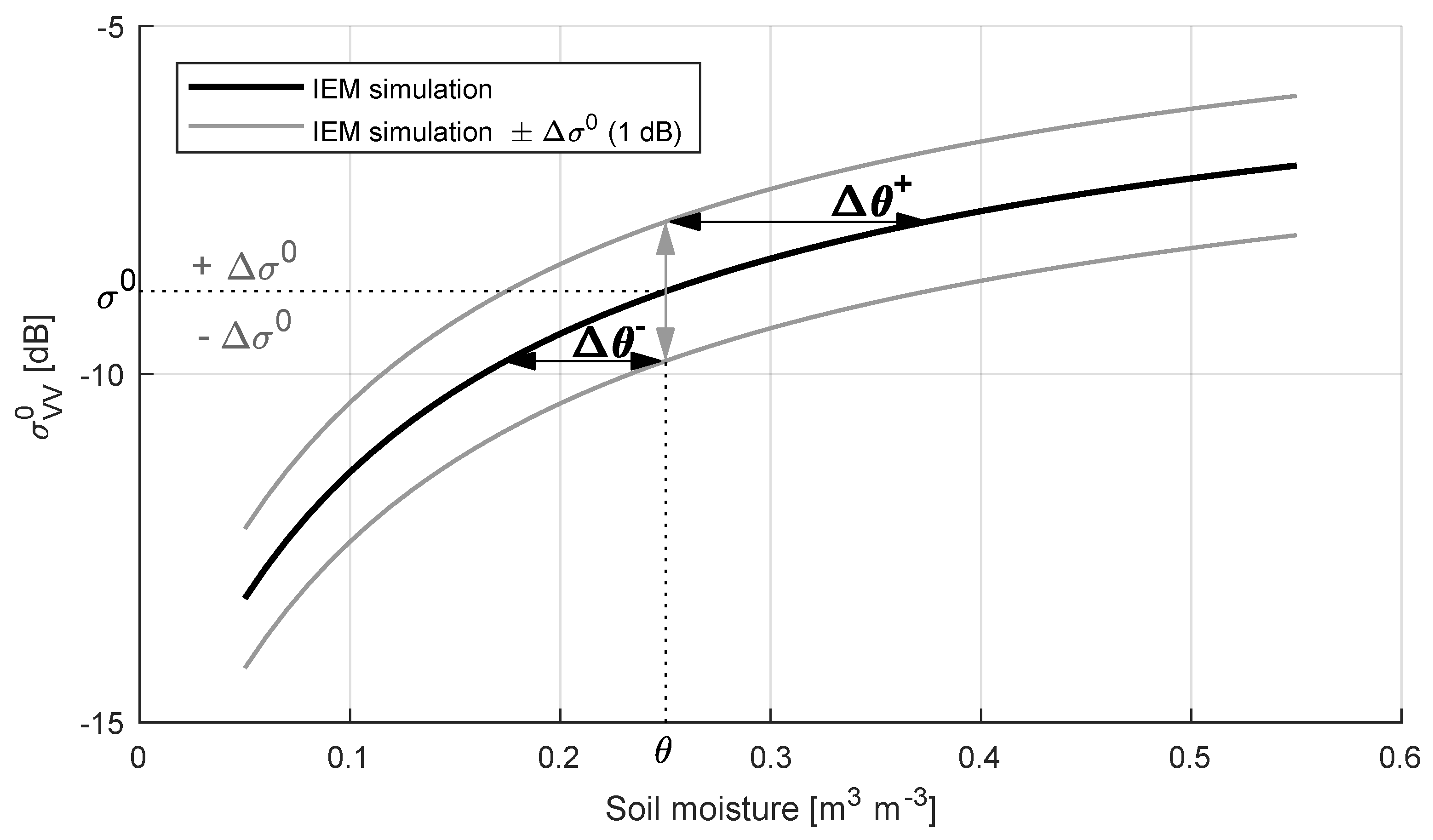
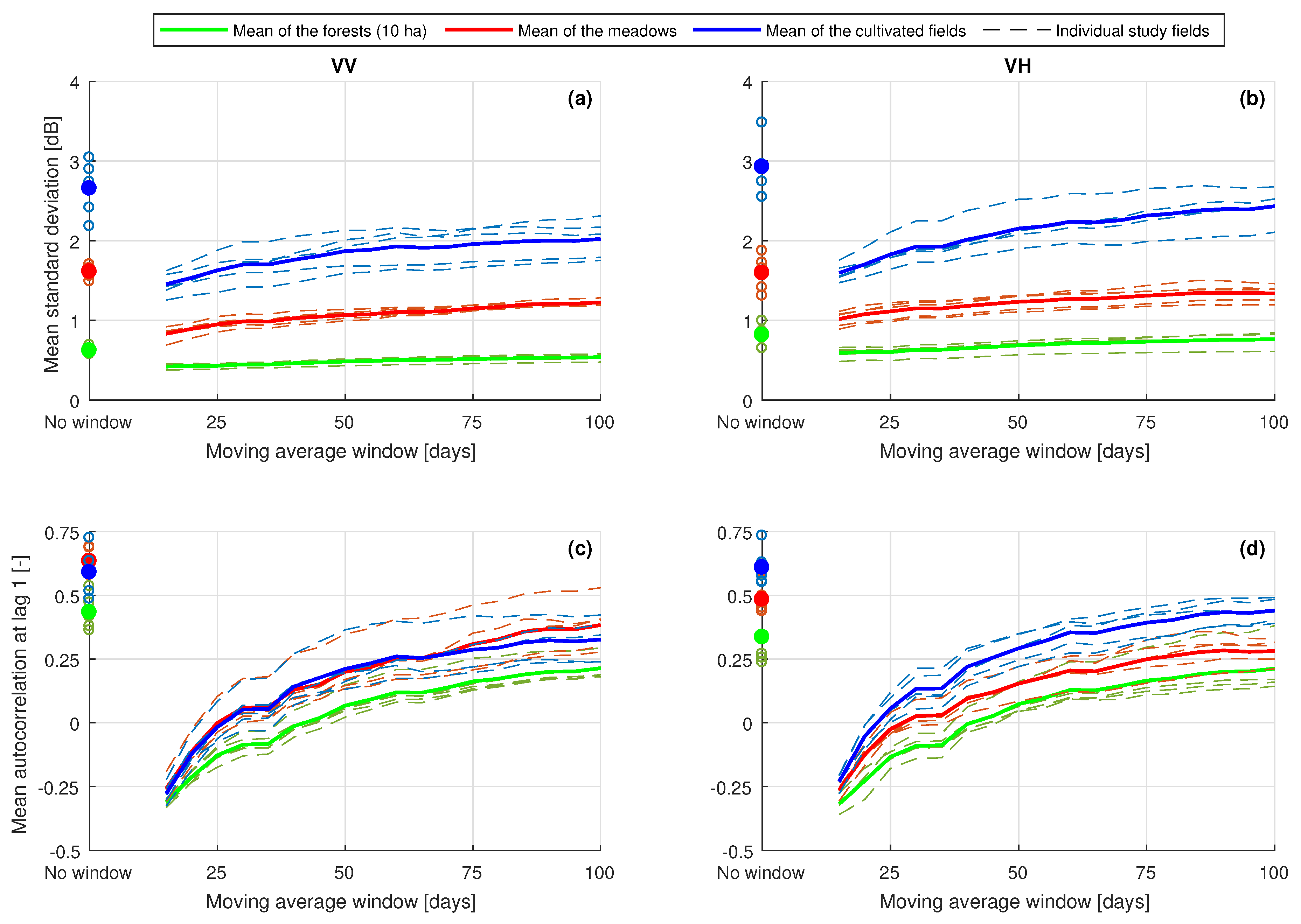
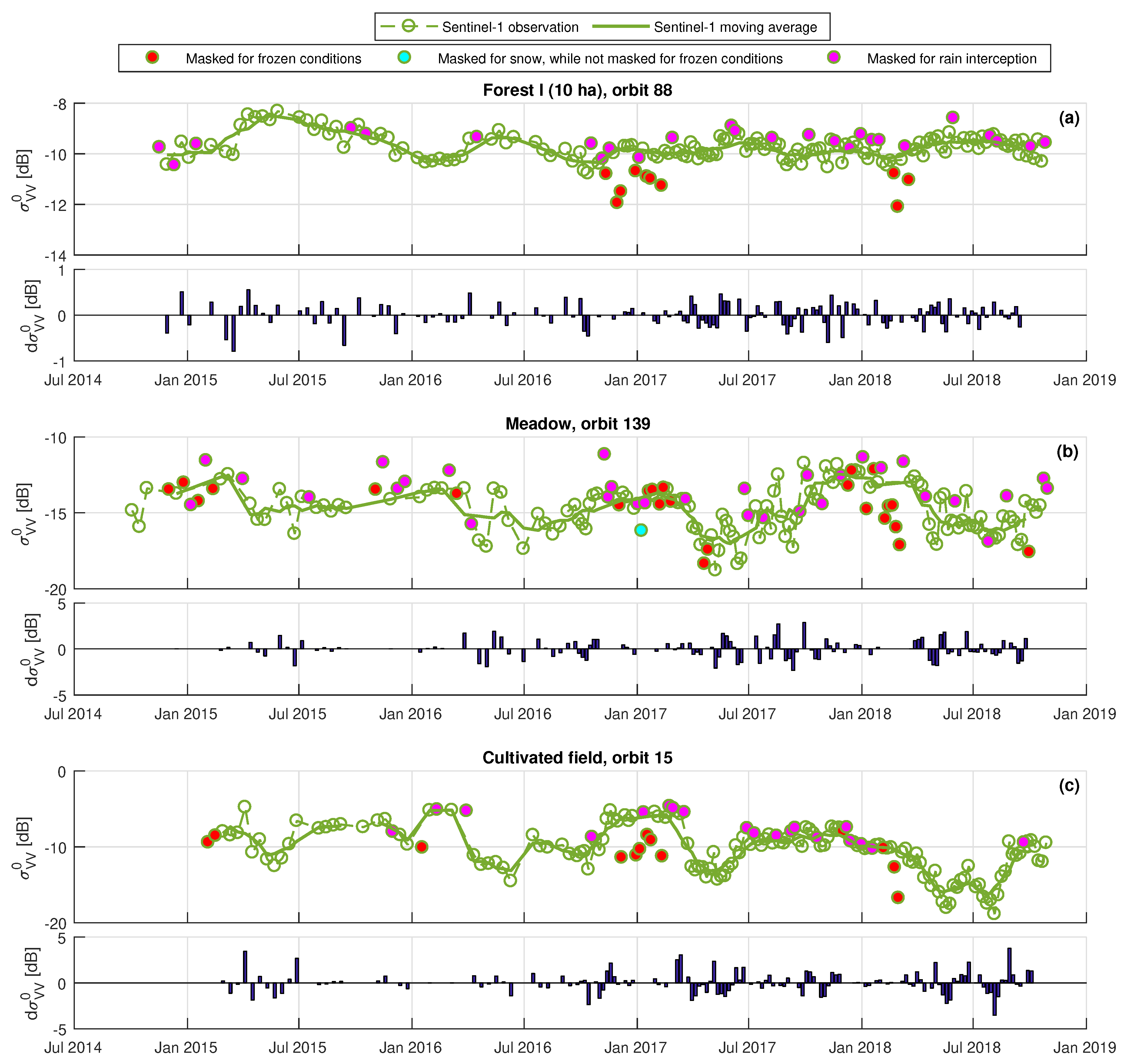


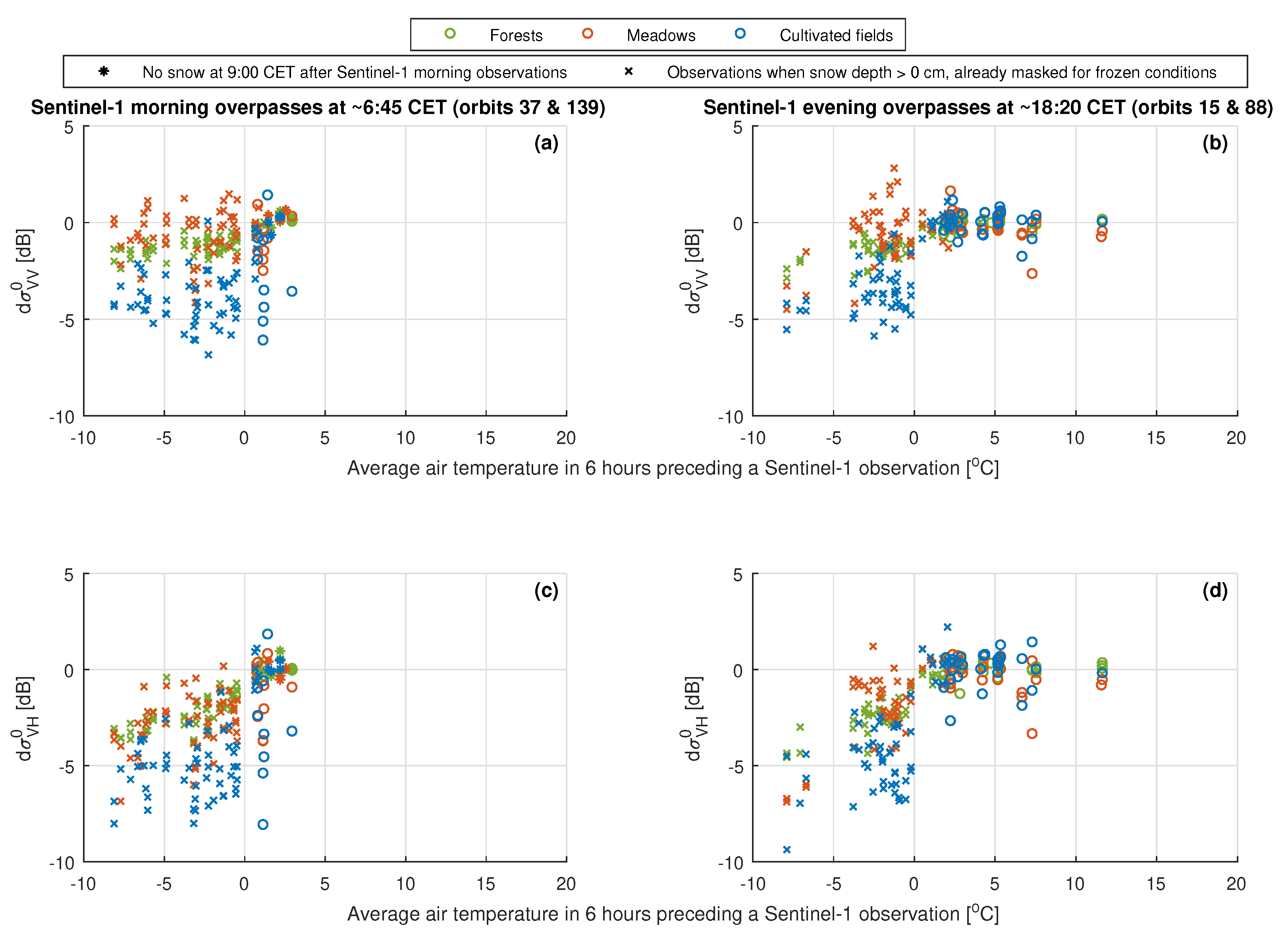

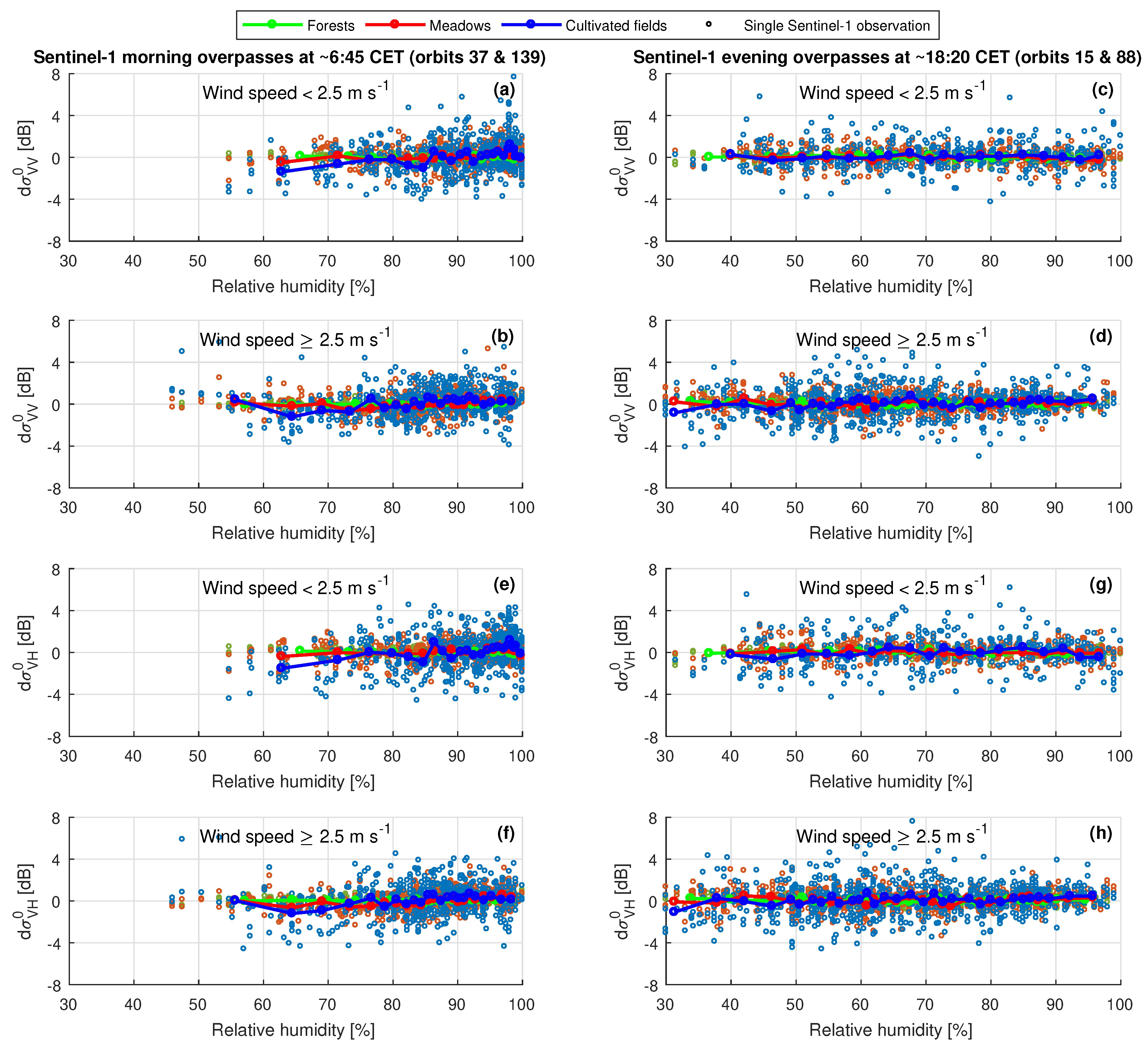
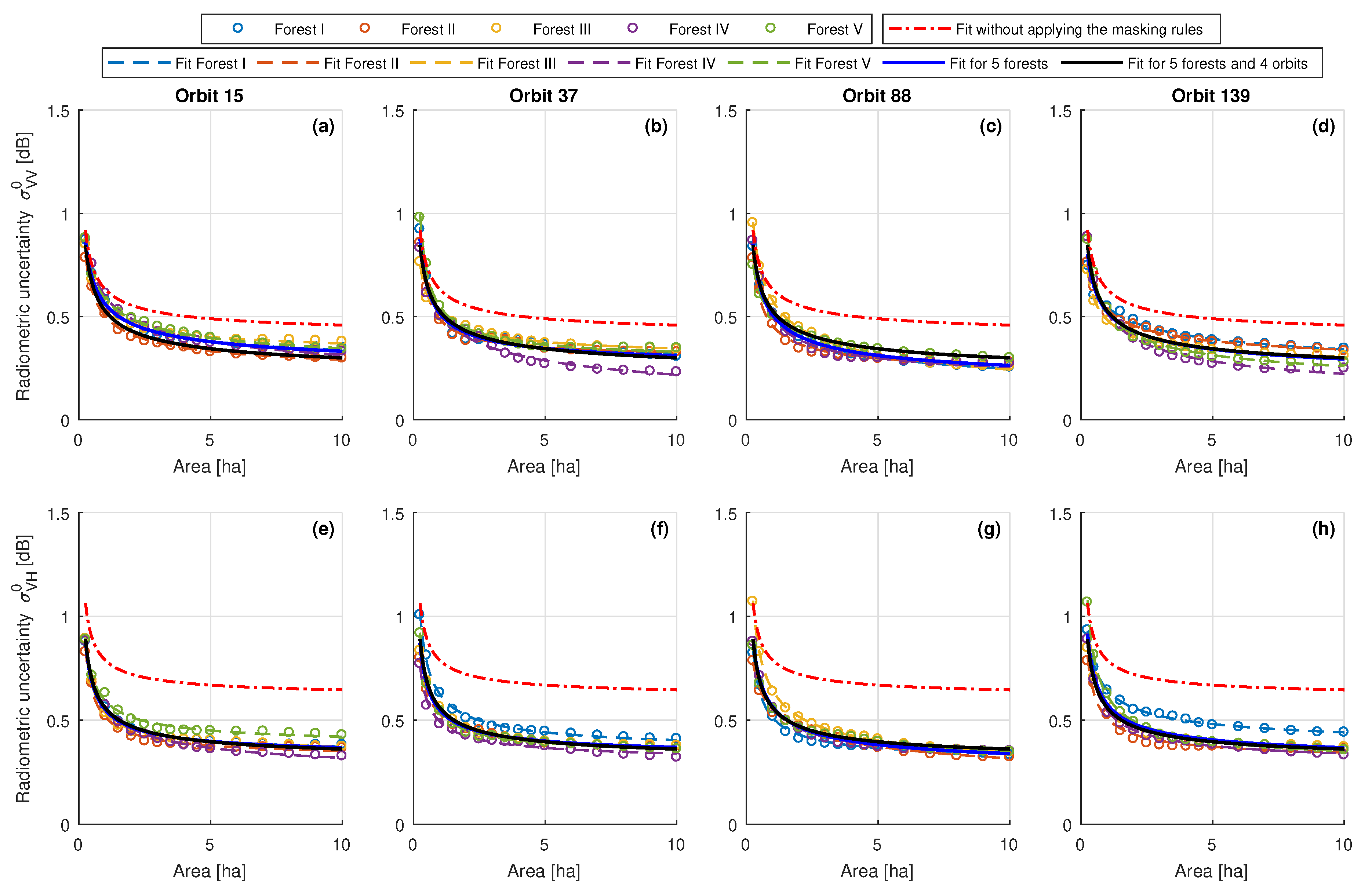



| Condition | Twenthe | Hupsel | Heino |
|---|---|---|---|
| Minimum monthly mean air temperature [] | 2.9 (January) | 3.2 (January) | 3.0 (January) |
| Maximum monthly mean air temperature [] | 19.0 (July) | 19.0 (July) | 18.7 (July) |
| Number of days per year on which the air temperature dropped below 0 | 53 | 49 | 49 |
| Annual amount of rainfall [] | 830 | 744 | 740 |
| Number of days per year with rain (minimum 1 /day) | 139 | 124 | 131 |
| Relative Orbit | Pass Direction | Acquisition Time (CET) | Number of Sentinel-1 Images | Projected Incidence Angle over the Study Fields |
|---|---|---|---|---|
| 15 | Ascending | 18:16 | 165 | 32.8–36.8 |
| 37 | Descending | 6:49 | 166 | 33.7–38.4 |
| 88 | Ascending | 18:24 | 171 | 41.2–45.1 |
| 139 | Descending | 6:41 | 174 | 41.5–46.2 |
| Scenario | z [cm] | [cm] | Source |
|---|---|---|---|
| Cultivated fields | 1.1 | 11.5 | Average of the measurements for corn fields during SMAPVEX-12 [66] |
| Meadows | 0.94 | 14.8 | Average of the measurements for pastures during SMAPVEX-12 [66] |
| Very smooth surface | 0.5 | 10 | Added for reference purposes |
| Surface Condition | Masking Rule | Mean of [dB] | ||
|---|---|---|---|---|
| Forests | Meadows | Cultivated Fields | ||
| Frozen conditions | −1.0 | −0.88 | −2.39 | |
| Snow | & at 9:00 CET after & Sentinel-1 morning observation & Land cover meadow or cultivated | Not masked | −0.52 | −1.93 |
| Rain interception | 0.36 | 0.73 | 1.39 | |
| Dew | No masking | Not masked | Not masked | Not masked |
| Surface Condition | Masking Rule | Mean of [dB] | ||
|---|---|---|---|---|
| Forests | Meadows | Cultivated Fields | ||
| Frozen conditions | −1.56 | −1.96 | −2.99 | |
| Snow | & at 9:00 CET after & Sentinel-1 morning observation & Land cover meadow or cultivated | Not masked | −1.09 | −2.04 |
| Rain interception | 0.43 | 0.91 | 1.53 | |
| Dew | No masking | Not masked | Not masked | Not masked |
| Relative Orbit | [dB] | |||
|---|---|---|---|---|
| All orbits in one fit | 0.3381 | −0.4809 | 0.1884 | 0.043 |
| 15 | 0.3556 | −0.4443 | 0.2042 | 0.029 |
| 37 | 0.2710 | −0.6091 | 0.2439 | 0.040 |
| 88 | 0.3706 | −0.4703 | 0.1377 | 0.031 |
| 139 | 0.3756 | −0.4035 | 0.1461 | 0.042 |
| Relative Orbit | [dB] | |||
|---|---|---|---|---|
| All orbits in one fit | 0.2705 | −0.5765 | 0.2891 | 0.041 |
| 15 | 0.2376 | −0.6341 | 0.3125 | 0.030 |
| 37 | 0.2355 | −0.6228 | 0.3128 | 0.039 |
| 88 | 0.3314 | −0.4940 | 0.2325 | 0.037 |
| 139 | 0.2872 | −0.5636 | 0.2888 | 0.049 |
© 2019 by the authors. Licensee MDPI, Basel, Switzerland. This article is an open access article distributed under the terms and conditions of the Creative Commons Attribution (CC BY) license (http://creativecommons.org/licenses/by/4.0/).
Share and Cite
Benninga, H.-J.F.; van der Velde, R.; Su, Z. Impacts of Radiometric Uncertainty and Weather-Related Surface Conditions on Soil Moisture Retrievals with Sentinel-1. Remote Sens. 2019, 11, 2025. https://doi.org/10.3390/rs11172025
Benninga H-JF, van der Velde R, Su Z. Impacts of Radiometric Uncertainty and Weather-Related Surface Conditions on Soil Moisture Retrievals with Sentinel-1. Remote Sensing. 2019; 11(17):2025. https://doi.org/10.3390/rs11172025
Chicago/Turabian StyleBenninga, Harm-Jan F., Rogier van der Velde, and Zhongbo Su. 2019. "Impacts of Radiometric Uncertainty and Weather-Related Surface Conditions on Soil Moisture Retrievals with Sentinel-1" Remote Sensing 11, no. 17: 2025. https://doi.org/10.3390/rs11172025




